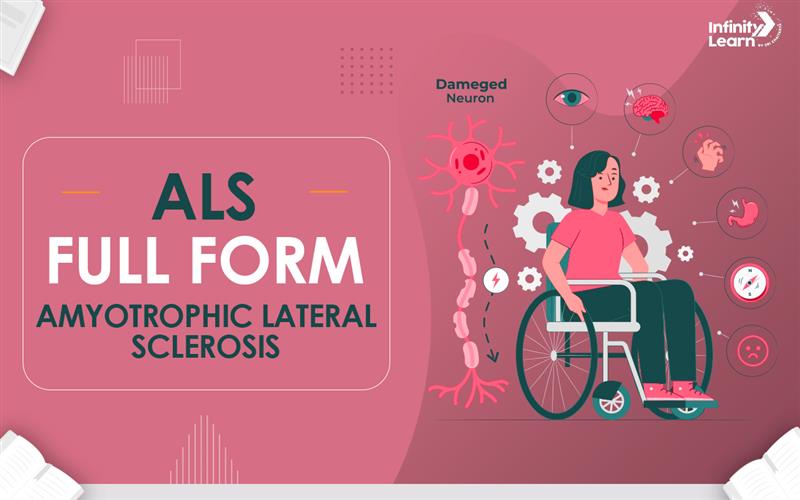Table of Contents
ALS full form is Amyotrophic Lateral Sclerosis. It is a disease that affects the nervous system, which means it hurts the brain and spinal cord. This disease makes it hard for the nerves to control the muscles, and over time, the muscles become weaker. ALS is also called Lou Gehrig’s disease, named after a famous baseball player who had it.
Doctors don’t know exactly what causes ALS, but in some families, it can be passed down from parents. People with ALS may first feel muscle twitching, weakness in their arms or legs, or have trouble speaking or swallowing. Later, it becomes hard to walk, talk, eat, or even breathe. Right now, there is no cure for ALS, and it is a very serious disease. But doctors can help treat the symptoms to make the person feel more comfortable.

What is ALS?
ALS (short for Amyotrophic Lateral Sclerosis) is a disease that hurts the nerve cells in your brain and spine. These nerve cells help your muscles move, like when you walk, talk, or eat. When someone has ALS, their muscles become weak over time and it gets harder to move.
At first, a person with ALS may feel muscle twitching or weakness in their arms or legs. Later, it may become hard to walk, hold things, chew food, talk, or even breathe. This happens because the muscles shrink and stop working properly. ALS is also known as Lou Gehrig’s disease, named after a famous baseball player from the 1920s who had it. Each year, about 5,000 people in the United States are told they have ALS.
There is no cure yet, but doctors are finding better treatments to help people with ALS feel better and live longer.
Do Check: AICTE Full Form
Full Form of ALS – Types
There are two types of ALS:
- Sporadic ALS: This is the most common type. About 9 out of 10 people with ALS have this kind. It happens randomly and is not passed down from parents.
- Familial ALS: This type is less common. About 1 out of 10 people with ALS have this kind. It is passed down in families because of gene changes from a parent.
Symptoms of ALS
The signs of ALS can be different for each person. It usually starts with muscle weakness and gets worse over time. The symptoms depend on which nerves are not working properly. Here are some common symptoms of AS:
- Trouble walking or doing daily tasks
- Tripping and falling often
- Weak legs, feet, or ankles
- Weak or clumsy hands
- Slurred speech or trouble swallowing
- Muscle cramps and twitching in arms, shoulders, or tongue
- Laughing, crying, or yawning at the wrong time
- Changes in thinking or behavior
ALS usually starts in the hands, feet, arms, or legs, then slowly spreads to other parts of the body. As more nerve cells die, muscles get weaker, and it becomes harder to chew, swallow, talk, and breathe.In the early stages, people with ALS usually don’t feel pain. Even later, pain is not common. ALS usually does not affect the bladder or the senses like touch, smell, taste, or hearing.
Do Check: ADHD Full Form
ALS Full Form – Causes of ALS
ALS is a disease that affects the nerves that help your muscles move. Doctors and scientists are still not sure what exactly causes ALS. But they think it happens because of a mix of different things.
One reason could be genetics. This means the disease can be passed down from parents to children. Some people are born with changes in certain genes that may cause ALS. Another reason could be the environment. Things like poisonous chemicals, viruses, or even injuries might also play a part in causing ALS.
ALS mainly affects motor neurons. These are special nerve cells that help you move your body. They send messages from your brain to your muscles so you can walk, talk, chew, and breathe. In ALS, these messages get mixed up or don’t go through, like when a phone call has a bad signal. Slowly, the messages stop completely, and the muscles can’t move anymore. That’s when people begin to have problems with moving and breathing.
Who is at risk of developing amyotrophic lateral sclerosis?
Every year, about 1 or 2 people out of every 1 lakh get ALS. Anyone can get it, but some people have a higher chance.
- Age: People over 40 years old have a higher chance.
- Race: White and non-Hispanic people are more likely to get it.
- Gender: Men get ALS more than women. But when people get older, the chances are the same for both.
ALS Medication
There are four main medicines approved in the United States to help people with ALS. These medicines don’t cure the disease, but they can help slow it down and make the person feel better.
- Riluzole is a medicine that helps protect the motor neurons, the nerve cells that control muscles. It can help people with ALS live a little longer, maybe a few more months.
- Edaravone helps to slow down the loss of muscle strength. It means the muscles won’t get weak as fast, so the person can do everyday things for a longer time.
- Tofersen is a special medicine for people who have a change in a certain gene called SOD1. This medicine helps reduce the damage to nerve cells.
- Doctors may also give other medicines to help with symptoms. These can help if a person has muscle cramps, stiffness, too much saliva, pain, or is feeling sad or stressed.
These medicines and treatments can make life easier for people with ALS, even though there is no full cure yet.
Do Check: Airbnb Full Form
ALS Therapies
Doctors may suggest different types of therapies to help people with ALS feel better and do daily things more easily. These therapies do not cure ALS but can make life more comfortable.
- Physical therapy helps you stay strong and safe. It includes easy exercises that keep your muscles working and help your body stay healthy.
- Occupational therapy teaches you how to do daily activities like eating, dressing, and bathing. It also shows you how to use helpful tools like wheelchairs, braces, or walkers without getting too tired.
- Speech therapy helps you with talking and swallowing. It teaches you ways to speak clearly for as long as possible and also how to use other ways to communicate, like using a board or writing, if talking becomes hard.
Nutritional Support
For people with ALS, it can become hard to eat and drink properly. Some may have trouble swallowing, which can cause weight loss and make it hard to get enough vitamins and minerals.A dietitian (a food expert) can help by making a meal plan with soft foods that are easier to swallow. They also help make sure the person gets enough calories, fiber, and water to stay strong.
As swallowing gets harder, the doctor may suggest a feeding tube. This tube helps the person get food safely without choking or food going into the lungs.
Breathing Support
As ALS gets worse, breathing can become difficult. Doctors may give a special mask that helps you breathe better. This is called noninvasive ventilation (NIV). You might wear it at night at first, and later, you may need it all day. Sometimes, a person may need a machine to help them breathe. This is called mechanical ventilation. If you ever feel short of breath, tell your doctor or care team. They will help you find the best way to breathe more easily.
Do Check: AFCAT Full Form
FAQs on ALS Full Form
What is the meaning of ALS and amyotrophic lateral sclerosis?
ALS is a disease that makes the muscles weak because the nerves stop working properly.
What is ALS called now?
ALS is still called ALS, and it is also known as Lou Gehrig’s disease
What are five symptoms of ALS?
Weak muscles, trouble walking, trouble speaking, muscle cramps, and difficulty swallowing.
Is ALS in females?
Yes, ALS can happen to both men and women.








